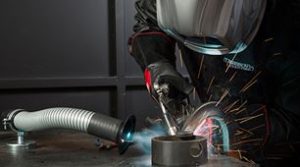 How to control exposure to welding fume
How to control exposure to welding fume
May 24, 2016 REDWIRE is news you can use from leading suppliers. Powered by FRASERS.
Posted by Lincoln Electric (Canada)
World Leader in the Design & Manufacture Of Arc Welding Equipment & Consumables, Robotic/Automation Welding Solu... Read more
Subscribe
Free REDWIRE e-newsletter

Arc welding fume contains very small particles from the consumables, base metal and base metal coating. Welders who are overexposed to these fumes, which typically contain complex oxides of iron, silicon and manganese, are at risk of developing various short- and long-term health issues. This is why the American Conference of Governmental Industrial Hygienists (ACGIH) reduced the Threshold Limit Values (TLV) for manganese 10-fold, from a 0.2 mg/m3 TLV to a 0.02 mg/m3 TLV for respirable manganese.
Since most Canadian provinces adopt exposure limits that are equal to the ACGIH TLV, welding shops across the country should take steps to reduce exposure. Lincoln Electric has released a white paper that highlights critical steps required to control exposure levels to welding fumes and meet the new TLV limits for manganese.
Methods for controlling exposure
Since each welding environment is different, Lincoln Electric recommends starting by identifying and assessing your actual needs and operating conditions. The best way to do this is by having an industrial hygienist analyze samples of the air in the breathing zone of the workers to give you a baseline relative to any exposure level. Be sure to evaluate the exposure to the welder, as well as the material handlers, stock keepers and others working in the facility, as fumes may migrate. It’s also important, when measuring to a TLV limit, to average the measurements throughout the worker’s shift.
Once this assessment is complete, there are multiple approaches to consider, which can help reduce exposures to acceptable levels. These can include a change in the welding process or procedure to generate less welding fume, or changing the way the task is performed to better protect the worker. Some options include isolating and separating the operation by moving it to a regulated area, ventilating the welding process and placing a barrier between the workers and the source. More than one of these may be implemented in most welding applications. However, if these steps don’t adequately control exposure, respiratory protection, such as the use of positive pressure options like supplied-air and powered air purifying systems, may be necessary.
Additional information
Since many factors can affect exposure levels, it’s important to understand that the the same solution may not work for everyone, according to Lincoln Electric.
If you need further assistance or more information about the new TLV for manganese, contact Lincoln Electric at weldingfumecontrol@lincolnelectric.com or (905) 565-5600. As a world leader in the design, development and manufacture of arc welding products, with locations across the globe, Lincoln Electric is well-positioned to help its customers reduce their exposure to harmful welding fumes.
Share
Posted by Lincoln Electric (Canada)
World Leader in the Design & Manufacture Of Arc Welding Equipment & Consumables, Robotic/Automation Welding Solu... Read more